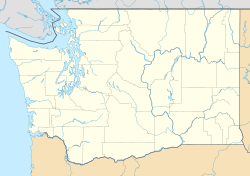Leque Island facts for kids
|
Location of Leque Island in Washington
|
|
| Geography | |
|---|---|
| Location | Pacific Northwest |
| Coordinates | 48°13′51″N 122°22′56″W / 48.2309°N 122.3823°W |
| Administration | |
|
United States
|
|
| State | Washington |
| County | Snohomish County |
Leque Island is a small piece of land in Snohomish County, Washington, United States. It sits near the bridge connecting Camano Island and Stanwood. You can find it where the Stillaguamish River meets Puget Sound.
Originally, Leque Island was a salt marsh. This is a coastal wetland that saltwater flows into. Over time, people built dikes (walls) around it for farming. This stopped the ocean tides from reaching the island. Because of this, areas not used for farming changed into freshwater wetlands.
Contents
History of Leque Island
How Leque Island Formed
About 12,500 years ago, a huge mudflow from a Glacier Peak volcano eruption helped create Leque Island. This mudflow brought most of the rich soil that makes up the island today.
Early People and Settlers
Native American tribes lived near Leque Island for thousands of years. They fished and gathered food from the waters around the island.
In the 1800s, the first Europeans arrived. They were mostly loggers who set up a sawmill on the island. Later, in the 1870s, a Norwegian settler named O. B. Iverson and his partners bought Leque Island. They wanted to use it for farming.
These families built dikes and dug ditches to control flooding. They grew crops like oats and hay and raised cattle. These families farmed the land for many years.
Leque Island Today
Since 1974, the Washington Department of Fish and Wildlife has bought parts of the island. They hire farmers to grow grains for waterfowl (birds like ducks and geese) that spend the winter there.
Today, Leque Island is a Wildlife Recreation Area. People visit to watch birds, take photos, and hunt ducks, geese, and pheasants during hunting season. Pheasants are even raised on the island for this purpose.
Water on Leque Island (Hydrology)
The Stillaguamish River brings fresh water to Leque Island. It also carries nutrients and dirt, which helps the island's plants grow. The water underground on the island is usually very close to the surface. This means water often flows into the man-made drainage ditches.
Plants of Leque Island (Flora)
Common Plants on the Island
Some parts of Leque Island are not farmed. These areas have many plants that are not native to the region. These include reed canary grass, holly, Himalayan blackberries, and oxeye daisies.
You can also find native plants like common rushes, reeds, sedges, and cattails. Other native plants include yarrow, ferns, blue aster, thistles, and sweet pea.
Farmed and Marine Plants
Farmers on the island grow corn and wheat. In the waters around the island, you might find marine plants like red kelp, pickleweed, and eelgrass. These plants are important for the marine life in the area.
Animals of Leque Island (Fauna)
Birds and Mammals
Leque Island is home to many different kinds of birds. You can see marsh hawks, western sandpipers, loons, seagulls, peregrine falcons, ducks, geese, and great blue herons. It's a major stop for birds traveling along the Pacific Flyway.
Small mammals also live on the island. Rodents make homes in the tall grass. Raccoons look for food like crabs on the beach. You can also find insects like bees, butterflies, and crickets.
Marine Life and Salmon Life Cycle
The waters around Leque Island are full of marine animals. These include different types of clams and shrimp. You can also find Dungeness crabs.
Many types of salmon and trout live here, including Chinook salmon. A study by the Stillaguamish Tribe found that young Chinook salmon depend on the estuaries (where the river meets the sea) around Leque Island. They recommended restoring these areas to help the salmon.
Port Susan Marine Stewardship Area
In 2007, the Port Susan Marine Stewardship Area (MSA) was created. This area includes all of Port Susan Bay and Leque Island. Different environmental groups manage the MSA. Their goal is to make the waters around the island healthier. They know that the changes made for farming, like building dikes, have affected the ocean environment.
Plans for Restoration
Restoring the Island's Natural State
A project was planned to bring parts of Leque Island back to a more natural state. The main group funding this project was Ducks Unlimited. They received grants to help with the restoration.
The plan was to remove part of the dike around the island. The materials from this dike would be used to build a new dike closer to the highway. This would allow the river's fresh water to flow into areas that had been cut off for about 100 years.
This project would let the ocean tides flow over a large part of the island again. This would create new wetlands where the river meets the sea. About 100 acres would still be freshwater wetlands and used for recreation and some farming. The goal was to improve the habitat for young salmon, including species that are threatened.
Challenges and Delays
The restoration project faced some challenges. Local groups were worried that removing the dikes could harm the water supply for Camano Island. Several experts studied this concern and found that the dikes' removal would not affect Camano Island's water. However, these concerns caused delays.
Even after many years and a lot of money spent, the restoration work had not fully begun. Some people are still concerned that the project might affect hunting and bird watching on the island. They also worry about losing the pheasant release site and flooding farmland.


